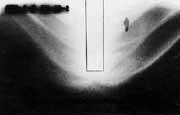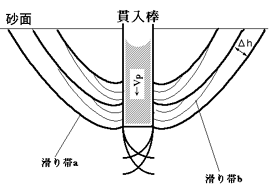Why Does Musical Sand Sing?
The mysterious sound of musical sand. For many years its mechanism was considered a mystery, but in fact, it has been completely explained by modern science. The professor used to say, "The explanation of the sound mechanism is complicated, so I keep it a mystery for the general media," but since this is a website, let's take a slightly more detailed peek into that secret.
The World Inside the Sand, Seen with X-rays
 |
 |
The photos above were taken with a special X-ray camera at the moment a rod was pushed into ordinary sand and singing sand, respectively. The difference is clear at a glance! While nothing changes in the ordinary sand (left), several distinct white lines appear within the singing sand (right).
These white lines are, in a sense, **"tiny faults"** that form instantaneously within the sand. In technical terms, they are called "slip bands." They appear white because the force of the rod pushing down causes layers of sand to regularly shift, creating gaps. This dramatic movement of the sand is the very source of that beautiful sound.

The "Stick-Slip Phenomenon" That Creates Sound
So, why does the formation of these "slip bands" produce sound? It's caused by a phenomenon called **"stick-slip,"** which arises from the large difference between **"static friction" and "kinetic friction."** The principle is similar to the "screeching" sound of fingernails on a chalkboard, or a violin bow drawing across a string.
Stick: When you push the rod in, the sand grains resist with the force of static friction, as if bracing themselves and saying, "I won't move!"
Slip: However, when the force exceeds a certain limit, the sand can no longer hold back and suddenly gives way (a shear failure). This is the "slip band." Once it starts sliding, the friction changes to the weaker kinetic friction, allowing the rod to sink in more smoothly.
Stick Again: But as soon as the force is released by the movement, the sand immediately returns to a state of static friction and braces itself again.
This rapid repetition of "bracing → suddenly slipping → bracing again" creates a fine vibration that rhythmically shakes the entire sand bed via the rod, reaching our ears as a beautiful tone.
The Formulas Uncovered by the Professor
This mystical phenomenon can be fully described with mathematical formulas. The equations below show how the width of the slip bands (Δh) and the frequency of the sound (f) are related to factors like the sand's friction and the diameter of the rod.
 |
 |
|---|---|
|
Δh = (B/2) {tan(π/4 + Φs/2) - tan(π/4 + Φe/2)} f = (N+1) (Vp / Δh) |
What these formulas prove is that "the greater the difference between static and kinetic friction, the lower the pitch of the sound." They also show that the sound has a pleasant resonance with frequencies in integer multiples (harmonics).
So, Why Doesn't Ordinary Sand Sing?
|
The answer lies in the "cleanliness" of the sand grains. The main component of musical sand is quartz, the same as crystal. When the surfaces of these quartz grains are naturally polished in a clean, unpolluted environment, the difference in friction becomes large, and the sand is ready to sing. Ordinary sand, on the other hand, is contaminated with various impurities, which makes the grain surfaces slippery. For this reason, the dynamic vibrations seen in the X-ray photos do not occur, and no sound is produced. |

|
Mineral Composition Analysis Results of Musical Sand

| Koshimizu Coast, Hokkaido | |
|---|---|
| Mineral Component | Content (%) |
| Plagioclase | 36.9 |
| Sedimentary rock fragment | 29.2 |
| Clinopyroxene | 12.5 |
| Quartz | 7.0 |
| Volcanic rock fragment | 6.6 |
| Orthopyroxene | 5.2 |
| Opaque mineral | 2.2 |
| Hornblende | 0.4 |
| Σ 100.0 |
| Itanki Beach, Muroran, Hokkaido | |
|---|---|
| Mineral Component | Content (%) |
| Plagioclase | 51.5 |
| Sedimentary rock fragment | 18.5 |
| Volcanic rock fragment | 13.2 |
| Quartz | 7.9 |
| Clinopyroxene | 4.3 |
| Shell fragment | 3.0 |
| Orthopyroxene | 0.7 |
| Hornblende | 0.3 |
| Garnet | 0.3 |
| Opaque mineral | 0.3 |
| Σ 100.0 |
| Okuya, Iide, Yamagata Pref. | |
|---|---|
| Mineral Component | Content (%) |
| Quartz | 98 |
| Sedimentary rock fragment | 2 |
| Σ 100.0 |
| Kakumihama Beach, Niigata Pref. | |
|---|---|
| Mineral Component | Content (%) |
| Quartz | 28.9 |
| Sedimentary rock fragment | 23.0 |
| Volcanic rock fragment | 17.2 |
| Plagioclase | 16.2 |
| K-feldspar | 14.2 |
| Orthopyroxene | 0.5 |
| Σ 100.0 |
| Kotohiki Beach, Kyoto Pref. | |
|---|---|
| Mineral Component | Content (%) |
| Quartz | 43 |
| K-feldspar | 33 |
| Sedimentary rock fragment | 15 |
| Plagioclase | 6 |
| Volcanic rock fragment | 2 |
| Shell fragment | 1 |
| Σ 100.0 |
| Kotogahama Beach, Shimane Pref. | |
|---|---|
| Mineral Component | Content (%) |
| Quartz | 50 |
| K-feldspar | 22 |
| Plagioclase | 14 |
| Sedimentary rock fragment | 9 |
| Hornblende | 2 |
| Clinopyroxene | 1 |
| Shell fragment | 1 |
| Volcanic rock fragment | 0.5 |
| Epidote | 0.5 |
| Σ 100.0 |
| Aneko-no-hama Beach, Fukuoka Pref. | |
| Mineral Component | Content (%) |
| Quartz | 75 |
| Plagioclase | 15 |
| K-feldspar | 2 |
| Amphiboles | >1 |
| Biotite | >1 |
| Rock fragment | 7 |
| Shell fragment | 1 |
| Sand from the Badain Jaran Desert | |
|---|---|
| Mineral Component | Content (%) |
| Quartz | 50.5 |
| Sedimentary rock fragment | 26.2 |
| K-feldspar | 12.3 |
| Plagioclase | 7.1 |
| Volcanic rock fragment | 3.0 |
| Zircon | 0.3 |
| Epidote | 0.3 |
| Opaque mineral | 0.3 |
| Σ 100.0 |
(The measurement was commissioned to Mr. Taku Fujiwara of the authoritative Masutomi Geology Museum in Kyoto. He accurately performed this very troublesome analysis.)
